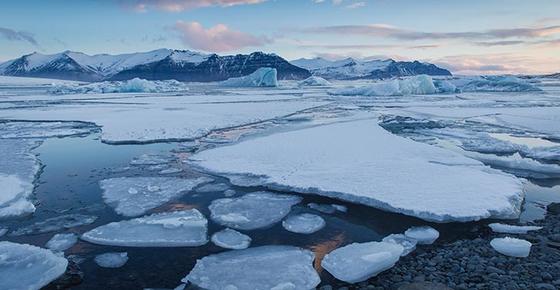The Arctic is warming at more than twice the rate of the rest of the planet, but for a team of researchers at George Mason University that’s just the tip of the iceberg of the changes to come.
The team members, led by faculty from Mason’s Volgenau School of Engineering and the School for Conflict Analysis and Resolution, are diving into how melting ice in the Arctic will affect the people, habitats, and social fabric of this remote region.
The National Science Foundation grant, “An Expanding Global Maritime Network, Its Arctic Impacts and Reverberations,” provides the resources, time, and support to better understand this global challenge and to help mitigate its effects on the Arctic.
“Our project is not about whether climate change is real,” says Elise Miller-Hooks, professor, the principal investigator, and Bill and Eleanor Hazel Chair of Infrastructure Engineering at the Volgenau School. “We are considering the effects of the sea ice melting in the Arctic and the potential for this change to affect world trade flows and a myriad of things that connect to these flows.”
As previously ice-bound passageways open, shorter trade routes will save time and money in the transport of goods and services. Some call this route the new Northwest passage, referencing the path to China that explorers from European nation-states of the 15th century sought but never found.
“The opening up of this northwest route will affect trade in many ways,” says Miller-Hooks. “It will affect large nations and local economies. It will affect wildlife and the environment. It will affect transportation and infrastructure.”
As more traffic passes through the Arctic, the people who live there will experience both positive and negative effects. There will be changes in supply chains, increased pollution of the shipping lanes, and changes to the fragile arctic ecosystem. On the other hand, there will be jobs and the potential for economic growth, but these opportunities could disrupt the lives of indigenous people and threaten the survival of their cultures.
Sara Cobb, the grant’s co-principal investigator and director of the Center for the Study of Narrative and Conflict Resolution says, “The Arctic is sort of the canary in the coal mine.” Cobb brings her expertise in conflict and narrative studies as the team seeks to understand the impact of the coming changes and develop early warning systems for arctic communities.
“Those of us in the social sciences are good at qualitative work,” says Cobb, Drucie French Cumbie professor at Mason’s School for Conflict Analysis and Resolution. “Now the modeling work is so advanced that we need experts in that field.”
The study’s unique pairing of mathematical analysis with narrative studies aims to help develop tools that could lead to early responses to help mitigate the effects of the many changes in the Arctic.
Celso Ferreira associate professor in the Sid and Reva Dewberry Department of Civil, Environmental, and Infrastructure Engineering and a co-principal investigator on the grant, adds his knowledge of flood hazards to the team.
As it turns out, sea ice in the Arctic protects coastlines from erosion like the marshes and wetlands protect the Chesapeake Bay that he studies. “As the Arctic ice diminishes the coastlines are more vulnerable to storms and erosion,” says Ferreira. The team hopes to be co-producers of knowledge with the people who live in these areas as they develop sustainable solutions to the challenges of the ice melt.
“The Arctic ice melt is a big problem. Big problems demand big answers and big teams,” says Miller-Hooks. “We are leading a team of experts from many different areas, including civil engineering, applied mathematics, anthropology, ice physics, coastal dynamics, and narrative approaches to conflict analysis and resolution.”

Ultimately the research team wants to develop a toolbox that will support research around the globe with Mason researchers at the center of the work. The toolbox will include mathematical techniques for modeling how the goods will be rerouted under different scenarios. It will also consider the risks associated with the new trade routes made possible by the melting ice.
The researchers will seek to understand the coastal dynamics, consider how to best build on the melting permafrost, investigate how to plan for emergencies when the ice breaks apart, and look at the cultural impacts.
Miller-Hooks says the team’s work has opened her eyes to the interconnectedness of our world. Although she has traveled around the globe, she never thought she would visit the Arctic—it seemed so distant and remote. “I realize now that we are all in this together. What happens in Nuuk, Greenland or Barrow, Alaska affects us all.”
